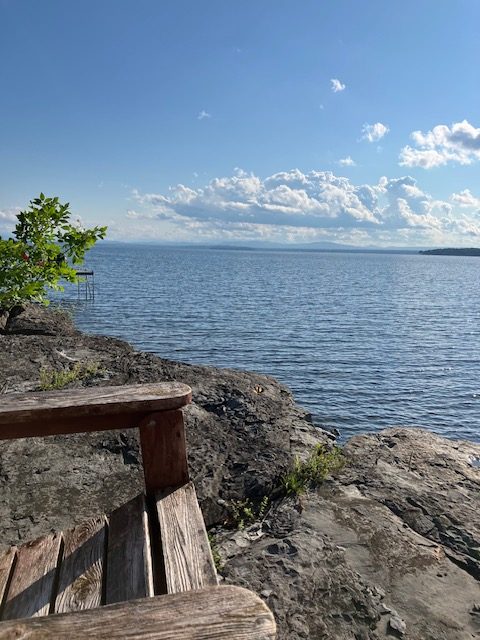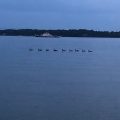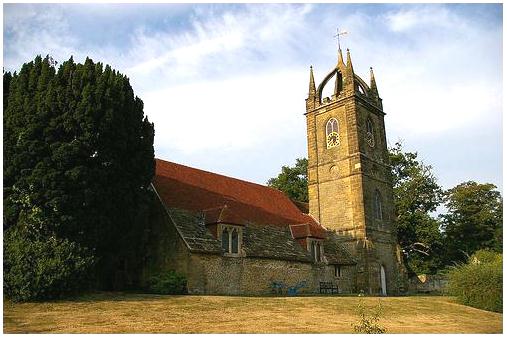Nine Nights in the North
On our last day in Vermont, the weather was perfect. The temperature was in the mid-seventies, the humidity was low, and the skies over Lake Champlain were finally clear of smoke. It was a Tuesday, and the lake was quiet. The occasional motorboat passed, sending its swells shoreward, but it was always far away, more toward the New York side. The ferries between Grand Isle and Cumberland Head were running, but their quiet hum had become, by this, our third summer in Grand Isle, just another local sound, pleasant and comforting, like the calls of the shorebirds or the lap of the waves on the rocks behind us. We were at peace, longing for nothing more than to stay exactly where we were, and as the shadows lengthened and the afternoon turned toward evening, we sat out past when we usually did, feeling a part of the landscape, of the sun, the wind, and the water.
At some point we did go up to the cottage to eat and to pack for an early getaway the next morning, but we came back down to the lake later, in jeans and long-sleeved shirts, to take strength from the space and the distance and to watch the setting sun blaze a path across the darkening surface of the lake and then sink behind the blue hills of the Adirondacks.
We split our vacation this year and were just back from three nights in a log cabin in the Adirondacks, a cabin so quiet it made the peace of the Champlain Islands seem thunderous. The Adirondacks are only on the other side of the Champlain Valley, but as soon as you turn off New York’s I-87 and start driving west, you understand you’ve entered a different kind of landscape: a more rugged, more primitive, sharper-edged topography, with broken pines twisting into the sky and rocky hills riven by gorges of cascading water. The traffic on the state highways thins out, the distance between hamlets increases, the number of lakes rises exponentially, waterscapes fringed by forest, marsh, and bog.
The Adirondack Park was, more than the rolling farmland of Vermont, the landscape of my childhood summers, the names of its lakes and its mountains calling up memories of the past. My family camped, traveling in an old-style wood-paneled station wagon, a soft-shelled tent trailer hitched behind us, with a red fiberglass canoe mounted on our roof. Inside, the car was packed to the gunnels, the green Coleman cooler, the boxes of food, the picnic hamper, and all the other essential items for two weeks in the woods fitted together by my father the night before we departed much as I imagine the ancient Egyptian pyramid builders fit together their blocks of granite and limestone. With meticulous precision, no gaps or spaces, every angle and corner true. At no time, however, did any of these items rise above my father’s line of sight. A well-packed car, a clear view to drive. Such were the rules he lived by.
The roads of the Adirondacks are full of SUV’s now. The only station wagon I saw was on exhibit at the Adirondack Museum, but as my husband and I drove from point to point (in our own SUV), from Indian to Blue Mountain Lake, past Raquette and out to Lake Sagamore, I could feel the ghost of the old station wagon traveling with us, or perhaps just out in front, having disappeared around that bend or down that dirt road marked as the entrance to a camp ground or a particularly good trail.
On our way back to Vermont, we drove back to the New York side of Lake Champlain, to Ticonderoga to visit the eighteenth-century fort built by the French and later occupied by the British, the Americans, and then the British again who abandoned it in 1781. The present approach to the fort is through a well-tended, English-style park, and it is only when you crest the hill that the view of the lake valley opens out before you, the southernmost shores of Lake Champlain flanked by bluffs and mountains, the bend in its wooded shores as they disappear south toward Lake George. A spot of great natural beauty, of history, of death, and of dying. The former lands of the Iroquois, the site of multiple military engagements as the French and British empires battled one another while the American nation struggled to be born. We toured exhibits about sieges, guns, eighteenth-century army medical care (not much), and soldiers who were under orders to grow their own vegetables. We talked to reenactors stirring murky pots of stew, making shoes, and setting lessons for the vanished children of a garrison once 2000 strong now reduced to four lone defenders demonstrating musket fire for the tourists in the afternoon drizzle.
Traveling back to Vermont via I-87 north and the ferry from Cumberland Head, we returned to the tended fields of the Champlain Islands, to less drama and a bit more human community, and to the cottage we’ve grown to love with its views of the fields and the lake.
The day finally came of course when we had to leave them to return to Connecticut where the summer heat and humidity are inescapable, where we don’t live on the shores of a great body of water or have a view of distant mountains, and where, at this writing, the smoky haze from the Canadian wildfires has reached us as well. Instead of gorges filled with rushing torrents, we hear a low August trickle in the streams to either side of us. Completely surrounded by trees, we cannot see for miles into another state, or even the entirety of our neighbor’s houses.
We do have our birds, birds of the forest, not of the shore: woodpeckers, crows, titmice, jays, a pair of cardinals who seem particularly devoted to one another. I sit shotgun in the mornings on the front stoop (with a camera) to keep the birds and squirrels off while the chipmunks eat their morning seeds. I check the herb garden for butterfly and bee activity and scan the raspberry bushes for leftover splashes of color. Surrounded now by the insistent insect buzz of August, of a summer already tipping toward fall.
Yet this too is sustaining, not in the same way as the concentrated rush you feel from the dramatic vistas of great lakes and high mountains, but from a quieter satisfaction in a day-to-day conversation with nature. I scold the squirrels and the titmice and gently encourage the chipmunks to emerge from the ivy and the boxwood after their rivals have gone. I call to the mother turkey who parades regularly through our yard to let her poults take dirt baths in the vegetable garden and keep an eye out for the hawk who drops down from time to time to drive the other birds into hiding. These creatures and views are here, not hundreds of miles away. I don’t have to drive to see them. Yet they too move me as I open our front door and go outside where they meet me, in our own small oasis of nature.
* For my mother, who was also in that tightly-packed car, on what would have been her 102nd birthday.





It sounds more refreshing and restorative than any medicine or beverage.
Wonderful travelogue. And a lovely description of finding respite at home, too.
Sounds lovely, Linda! Best to you and Tony!
A great travelogue beautifully describing nature.
Your interactions with nature bring it to another level of beauty..
Thank you for taking me on vacation!
Lovely description of your trip. It brings back memories of trips to the Adirondacks. I think I inherited the packing gene from Dad. No seat belts back then, we were on top of the camping gear with the dog.
What a nice story Linda….and you’re so descriptive, paint a clear picture. Thanks …best to you and Tony!